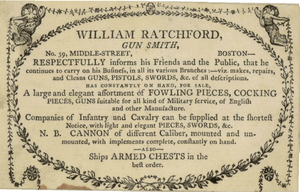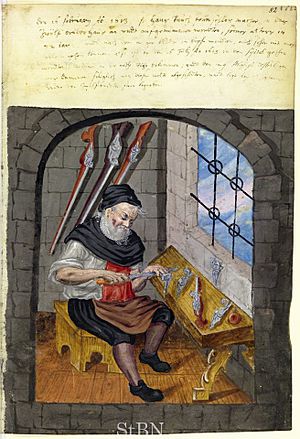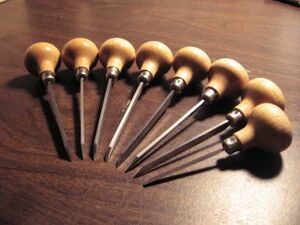Gunsmith facts for kids
A gunsmith is a skilled person who makes, repairs, or designs guns. Their job is a bit like an armorer, but a gunsmith often creates new parts or customizes firearms, while an armorer mainly maintains and repairs existing ones. The word "gunsmith" has been around since the 1580s.
Contents
History of Gunsmithing
The very first firearms appeared in China around the 1200s. In Europe, skilled Italian craftsmen were the first to make gun barrels. Gunsmithing was a new trade in the Middle Ages. For a while, gunsmiths didn't have their own special groups called guilds. Many of them joined the guilds of blacksmiths instead.
By the mid-1400s, there were enough gunsmiths to form their own guilds. One of the first was in 1463 in Suhl, Germany. England was a bit slower to develop gunsmithing. To help this, King Henry VIII invited top gunsmiths from Europe to come and work in England. Many accepted, and soon more gun shops opened in England. Several appeared in London near the Tower of London, where the country kept its large collection of guns. These new gunsmiths then taught English citizens this important new skill.

Before the American Revolutionary War, making guns in the American colonies was a very time-consuming job. Gunsmiths usually made guns and then repaired them for their customers. These gunmakers came to America from England, and later from Germany and Switzerland, countries known for their long history of gun making.
Young people learned the trade by becoming an apprentice to an experienced gunsmith. They would work from their teenage years into early adulthood before they could open their own shop. While handguns were often imported and cheaper, American gunsmiths mostly repaired and changed them. However, muskets and rifles were not imported as much. Local gunsmiths would custom-make these for their customers. Their work included carving gun stocks, engraving metal parts, and forging gun barrels. It could take up to 400 hours to make a gun by hand!
Soon, completely new guns were created, like the Pennsylvania rifle. This rifle was later called the "Kentucky rifle." It was made by German gunsmiths who moved to Pennsylvania in the early 18th century. This new rifle was lighter, longer, and much more accurate than European designs. It quickly became a favorite for colonial settlers and Frontiersmen.
Around the mid-1700s, a gunsmith named Honoré Blanc came up with the idea of interchangeable parts for muskets. This meant that each part of a gun would be made exactly the same, so they could be swapped out easily. Other European gunsmiths weren't very interested, but the American Ambassador to France, Thomas Jefferson, saw the potential. Jefferson quickly realized that making weapon parts in large numbers would help America avoid relying on Europe for gun parts. He couldn't convince Blanc to move to the United States, but he did convince President George Washington that it was a great idea.
In 1798, Eli Whitney received the first contract to build 12,000 muskets using this new system. Whitney used many unskilled workers and machines to produce identical parts at a low cost. This was around the time that gun manufacturers started to become different from gunsmiths.
What Gunsmiths Do
Gunsmiths can work in many different places:
- In factories for gun makers, often in special "Custom Shops."
- In armories for the military or police.
- In sporting goods stores.
- In small gunsmith shops, either as the owner or an employee.
To be a complete gunsmith, a person needs many skills. They must be good at making parts, working with metal and wood, and be an artisan. They also need to know about math, ballistics (how bullets fly), chemistry, and how different materials work. They must be skilled with many different hand tools, power tools, and measuring devices.
Those who own their own small gunsmith shops also need to be good at running a small business. They must work well with many different customers. Plus, they need to stay updated on all federal, state, and local laws about firearms.
Because there's so much to learn, many gunsmiths choose to specialize in just a few areas. Others might learn many skills but only apply them to certain types of guns, like only pistols or only shotguns.
Keeping Guns Safe
The main job of a gunsmith is to make sure guns work correctly and are safe to use. They do this by always showing and following proper gun safety rules themselves. They also make sure their customers and others around them are safe.
They also inspect guns carefully to ensure they operate safely. Gunsmiths use their deep knowledge of firearms and special diagrams called gun schematics to guide their inspections. They fix problems, tell customers about unsafe conditions, and prevent serious failures.
When inspecting a gun for repairs, a gunsmith looks for things like:
- Parts put together incorrectly.
- Missing parts.
- Cracks in the metal or wood.
- Things blocking the barrel.
- Problems with how parts fit together (like headspace or timing).
- Safety features not working.
- Worn parts like the sear or firing pin.
Gun schematics are like detailed maps of a gun. They are technical drawings that show all the inside parts and how they work. These diagrams usually have clear pictures of important parts like the barrel, receiver, trigger, and magazine. Gun enthusiasts, makers, and gunsmiths use them to find and fix problems with a firearm.
Common Gunsmith Tasks
Here are some common jobs a gunsmith might do, from simpler to more complex:
- Taking a gun apart, cleaning it, checking it, oiling it, and putting it back together.
- Removing rust and touching up the finish.
- Repairing damaged parts using special tools.
- Replacing broken parts with new ones from the factory, making sure they fit perfectly.
- Adding custom parts like:
* Straps to carry the gun (sling-swivels). * Pads to reduce kickback (recoil-pads). * Different sights for aiming. * Scopes for better accuracy.
- Repairing and refinishing wooden parts of the gun stock.
- Making or re-doing the textured patterns on the grip areas (checkering).
- Fixing or cleaning up worn designs or markings on the metal.
- Repairing damaged ends of barrels on a special machine called a lathe.
- Fixing dented shotgun barrels.
- Making sure the parts inside the gun fit together correctly (head-space).
- Checking for too much wear inside the barrel.
- Finding and fixing problems with how the gun loads, ejects shells, or fires.
- Test-firing guns with regular ammunition to make sure they work well.
- Making wooden stocks from scratch to fit a customer's body.
- Applying special material to connect the gun's action to the stock for better accuracy.
- Removing old metal finishes and applying new ones, like "bluing."
- Making new parts from raw metal.
- Adjusting the trigger pull to make it lighter or heavier.
- Firing special "proof-loads" through guns to ensure they are strong enough for high pressure.
- Replacing worn-out barrels that have been fired too many times and are no longer accurate.
- Changing the type of bullet a rifle uses by changing the barrel and modifying other parts.
- Designing and building complete rifles by putting together different parts.
- Designing and building a complete rifle, shotgun, or combination gun from start to finish. A "Drilling" is a complex, handmade gun with several barrels for both rifle and shotgun bullets.
Gunsmith Specializations
While some gunsmiths do a bit of everything, many focus on specific areas:
Custom Builder/Designer
These gunsmiths build guns exactly to a customer's wishes, using raw materials and parts. They might work for professional target-shooters or hunters who want unique features or very accurate firearms. They can also work with engravers and artists to create beautiful designs. This is one of the most skilled types of gunsmiths, as they need to know about metal finishing and machining to make individual parts themselves.
Finisher
A finisher applies special chemical treatments to the metal parts of guns. These treatments, like bluing or Parkerization, help protect the steel from rust. They might also do "case hardening" on steel parts. This process makes the surface of the steel very hard while keeping the inside tough. Sometimes, case hardening can create beautiful, colorful patterns on the metal, with blues, purples, and browns. This "color case hardening" is highly valued on expensive firearms.
Stockmaker
A stockmaker carves gun stocks, usually from wood like walnut. They fit the stock to the metal parts of the gun and also to the customer's body. For custom shotguns, a perfect fit is very important for accuracy. High-end firearms might have stocks made from very expensive wood with unique patterns. Making these stocks requires extreme skill, as they must look good, fit perfectly, and be strong enough to handle many shots. While some stocks are made by machines, high-quality ones are often made by hand using saws, chisels, and files.
Checkerer
(Often combined with a Stockmaker) A checkerer uses special tools to create a pattern of small, raised diamonds on the wooden grip areas of a gun. These tools are like tiny saws that cut V-shaped grooves. They make one set of parallel grooves, then another set across the first at an angle, creating the diamond pattern. The edges of the checkered area are often decorated with simple wood carvings.
Gun Engraver
A gun engraver uses hand tools or powered chisels to cut designs or pictures into the metal surfaces of a gun, usually the receiver. They must be talented artists who can draw designs freehand. The engraving might include scenes, animals, or even family members. The engraver needs to know about anatomy, perspective, and how to create a balanced design. They cut these designs into tough, hardened steel. Sometimes, other metals like gold or silver are added and then engraved to make the design even more special. Engraving is done purely for artistic reasons today, and high-quality engraving adds a lot of value to a firearm. Many art museums have decorated firearms because of their artistic beauty.
Pistolsmith
A pistolsmith specializes in working on pistols and revolvers. They need skills in woodworking, checkering, machining, and metalworking. They must deeply understand how handguns work. Often, a pistolsmith customizes a handgun to make it better for its purpose, like changing the sights for target shooting. They can even build highly accurate target pistols by hand-fitting parts together with extreme precision.
Manufacturer
Some gunsmiths use their skills to become small-scale manufacturers. They specialize in making only a few types of gun parts, which they then sell to other gunsmiths and gunmakers. Important parts they might make include barrels, trigger parts, and receivers.
Notable Gunsmiths
- Honoré Blanc (1736-1801): French gunsmith who first used interchangeable parts.
- Hugo Borchardt (1844-1924): German inventor of the Borchardt C-93 pistol.
- John M. Browning (1855-1926): Famous American inventor who created many firearms, including the M1911 pistol and the M2 Browning machine gun.
- Henry Deringer (1786-1868): Inventor of the Derringer pistol.
- John Garand (1888-1974): Canadian-American designer of the M1 Garand rifle.
- Richard Jordan Gatling (1818-1903): Inventor of the Gatling gun.
- Benjamin Tyler Henry (1821-1898): American inventor of the Henry rifle.
- Mikhail Kalashnikov (1919-2013): Soviet designer of the AK-47 assault rifle.
- Georg Luger (1849-1923): Austrian inventor of the Luger pistol.
- Hiram Maxim (1840-1916): American-born inventor of the Maxim gun.
- William B. Ruger (1916-2002): American gunsmith and co-founder of Sturm, Ruger & Company.
- Eugene Stoner (1922-1997): American designer of the ArmaLite AR-15 (later the M16 rifle).
- John T. Thompson (1860-1940): American Army officer, inventor of the Thompson submachine gun.
- Carl Walther (1858-1915): German gunsmith, founder of the Carl Walther GmbH Sportwaffen company.
Images for kids
See also
 In Spanish: Armero (profesión) para niños
In Spanish: Armero (profesión) para niños





